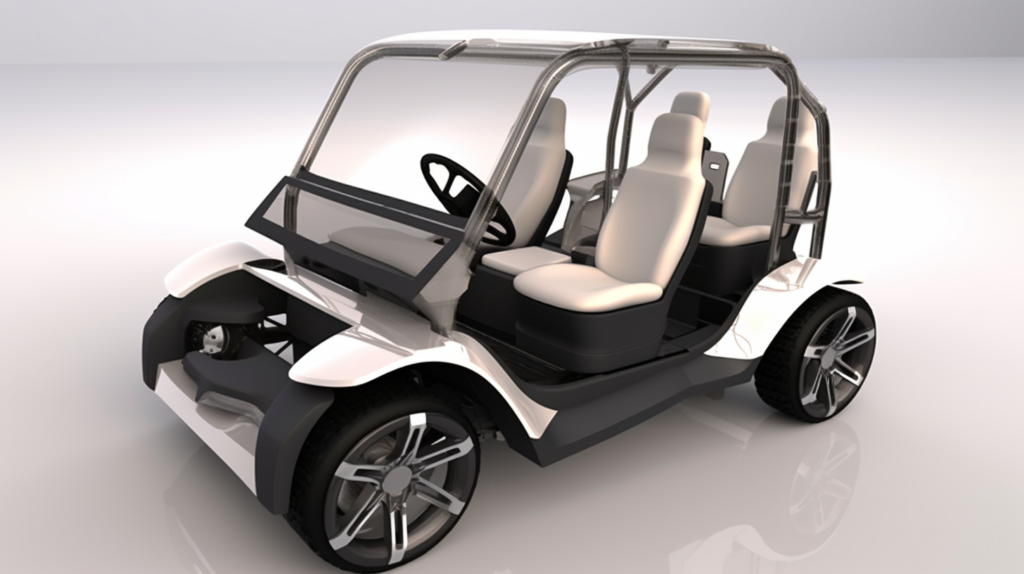Golf carts may seem tiny and featherlight, but scaling the scales reveals weight differences between hundreds of pounds that seriously change how they drive and function for golf and beyond.
The typical curb weight of popular four-seat golf carts falls between 800 and 1,200 pounds depending on included features, but even more impactful is properly matching ideal weight to intended duties.
Let’s dive in to see what makes golf carts heavy or light and why getting the weight right matters.
How Much Does a Golf Cart Weigh

The typical curb weight of a golf cart ranges widely from around 500 pounds for a basic lightweight two-seater model all the way up to 1,750 pounds for a heavy-duty luxury six-seater cart.
The average four-seat gasoline-powered golf cart splits the difference at between approximately 800 and 1,200 pounds. Large premium carts with additional features and accessories can exceed 2,000 pounds in some cases.
On the opposite end, stripped-down ultralight personal carts may dip below 500 pounds through very compact dimensions and lightweight materials.
Electric models also cover a wide spectrum but usually avoid the extremes of very heavy luxury or extreme lightweight configurations.
While weights fluctuate so widely, the 800 to 1,200 pound bracket makes up the majority of widespread four-seat gasoline-powered golf carts seen on courses and in resort communities countrywide.
This reasonably compact and comfortable design with seating for two to three passengers plus golf bags and supplies strikes an optimal balance of size to functionality for general consumer golf cart duty.
Consequently, buyers can expect this weight range to apply to average modern golf cart offerings from leading brands.
Factors Affecting Golf Cart Weight

Several physical characteristics intrinsic to golf cart design and construction influence the final curb weight figures. By understanding the aspects that make carts heavy or light, buyers can better evaluate specifications to choose the ideal weights for their intended cart purposes.
Performance, durability and transportation expectations should guide ideal golf cart weight selections.
Number of Seats/Size of Cart Body
The overall size and seating capacity built into a golf cart body directly relates to its total weight.
Golf carts come in two-seat, four-seat and six-seat layouts as well as personal transporters at minimum scale and oversized VIP limousines at maximum end of accommodations.
Naturally, installing more seats necessitates expanded frame dimensions, bodywork proportions and internal spacing. Bigger physical golf cart bodies translate to considerably higher curb weights even before accounting for accessories or powertrain capability.
A typical two-seat personal golf cart may weigh only 500 pounds versus 1,300 pounds or more for a luxury six-seater. Body scale ranks among the most significant golf cart weight factors.
Electric vs Gas Engine Powertrains
Golf carts rely on either electric or gasoline-powered drivetrains to provide their modest power needs. Electric models utilize battery packs and one or more electric motors while gas versions employ internal combustion engines and fuel systems instead of electric components.
Since batteries, motors and motor controllers stack up heavier than compact engines and exhausts, the selection of drivetrain prominently affects golf cart curb weights.
Differences in required chassis construction and powertrain mounting points also contribute to weight gaps among internal combustion engine and electric golf cart designs.
Construction Materials
The choice of construction materials from metals to composites determines the heft added by each golf cart body panel, frame member and hardware component.
Steel parts offer high strength for safety cages, suspension links and fittings but steel density causes considerable weight disadvantages versus alternative metals and composites.
Aluminum garners popularity through good durability and corrosion resistance while lowering density compared to steel components.
More expensive composite bodies and panels made of fiberglass, carbon fiber or reinforced plastics enable larger yet lighter golf cart enclosures than traditional metal pieces.
Every golf cart contains an array of materials tailoring vehicle weight to intended functionality and budget.
Presence of Custom Parts/Accessories
Installing aftermarket customizations or accessories provides endless ways to upgrade comfort, convenience and entertainment functions but also piles on the pounds.
Adding much heavier luxury seating in place of standard benches, huge storage lockers, entertainment systems, weather enclosure frames and outsized custom wheels or tires impacts golf cart weight.
Even accessories as small as cup holders, ball cleaners and decals collectively contribute unwanted mass. Limiting extras to just highly valuable or frequently used gear helps restrain overall cart weight.
Custom carts in particular should carefully balance desired features and tolerable heft.
Why Golf Cart Weight Matters

On the surface, golf cart weight may seem just a number with no real consequences. But extremes on both low and high ends entail tangible tradeoffs in performance, economy and practicality that degrade the intended easygoing golf cart experience.
Only by targeting efficient, purpose-driven curb weights can carts deliver their best balance of capabilities. Understanding where extra pounds truly help or hinder enables smarter weight decisions.
Impacts Gas and Electric Range Per Tank/Charge
Heavier golf carts require greater energy outputs to achieve the same speeds as lighter weight versions, sapping more battery charge or fuel per mile at speed. Cruising range directly suffers as a result simply through the physics of moving a heavier vehicle mass each trip.
Extra seating capacity in six-seat configurations or bulky custom accessories hence cut total distance or holes able to complete between battery charges or fuel stops.
Keeping unnecessary mass minimal therefore helps preserve intended golf cart functionality for full 18-hole trips without worrying over depleted energy reserves.
Hurts Gas Engine Fuel Economy
The gasoline engines powering conventional combustion engine golf carts must burn more fuel overall when installed in heavier cart bodies versus lightweight chassis.
Any increases in weight require more engine power during accelerations, slopes or higher speeds to push the bulk forward compared to lightly loaded engines.
Lower fuel efficiency directly results across typical golf course duty cycles given equal engines installed in lighter or heavier cart bodies. Consequently, avoiding overly luxurious features that pad on pounds pays dividends in reduced gas consumption.
Challenges Electric Battery Packs
Electric golf cart configurations must balance installed battery capacity against vehicle weight to ensure adequate range between lengthy recharges while limiting curb weight.
Heavier carts with oversized bodies, accessories or passenger loads drain battery reserves quicker through higher energy demands. Attempting to counter range losses via simply upsized batteries adds considerable weight while lowering efficiency further in a detrimental loop.
Optimizing electric golf cart weight versus seating and features therefore makes selecting appropriate battery specs markedly easier to sustain functionality.
Affects Responsiveness and Handling
While raw golf cart speed capability remains low, heavier weight adversely impacts acceleration, braking and transient handling just the same as faster vehicles when pushed.
Greater inertia from bulky carts makes building or shedding speed slower regardless of powertrain. Similarly, heavier masses struggle more with quick direction changes on slopes or in evasion maneuvers compared to agile lightweight carts.
Drivers inevitably notice sluggish control responses from heavily optioned luxury carts, while stripped down lightweight versions offer sportier reflexes.
Risk Exceeding Golf Course Limits
Golf course and resort community pathways must balance smooth reliable access for residents while protecting sensitive landscapes.
Consequently, many enforce reasonable weight limits regarding golf cart access to prevent overweight vehicles from causing damage through deeper soil traction marks, erosion or compression.
Custom oversized golf carts, especially those loaded down with accessories or riders, may easily exceed stated limits. Checking golf course or homeowners association policies provides assurance customized or upscale carts avoid issues.
Complicates Golf Cart Transportation
While golf cart functional needs center on the greens, owners must also occasionally transport carts between storage, homes and maintenance facilities.
Typical four-seat electric or gas models usually weigh at minimum 500-600 pounds even before considering bulky batteries in electrics. Luxury models often approach or exceed 1,000 pounds through substantial bodies and features on board.
Owners must seriously evaluate if personal trailers and lifts reasonably accommodate expected golf cart weights as needs arise. Outsized dimensions or mass complicate transportation logistics before purchases.
Checking planned storage access and doors ensures outsized weights or sizes do not later pose headaches transporting to or from the course or garage between rounds.
Targeting Ideal Golf Cart Curb Weight

Given the clear benefits of sensibly restrained golf cart weights regarding efficiency, driveability and practical factors, buyers should not simply default to the biggest, roomiest or most accessorized cart available.
Justifying true seating requirements, targeted range needs, desired driving performance and real accessory utility keeps extraneous pounds from dragging down fun.
Compact, lightweight golf cart models often surprise drivers with nimble athleticism and ample versatility as personal transport at just half the weight of overwrought luxury machines.
Test driving lightweight carts while avoiding assumptions bigger equals better rewards owners with balanced long-term functionality.
Keeping golf cart weight focused on core passenger and cargo needs pays dividends for unwavering enjoyment across every season of ownership duties ahead.
Conclusion
Golf cart weight has tangible impacts on performance and functionality. While heavy luxury models boast impressive curb appeal, lightweight options often deliver better efficiency, handling and convenience.
By realistically assessing passenger needs and avoiding accessory excess, buyers can find cartsbalancing durability, range and drivability for more smiles per mile. Whether choosing gas or electric power, keeping weight focused on core golfing duties makes for happy days ahead.



